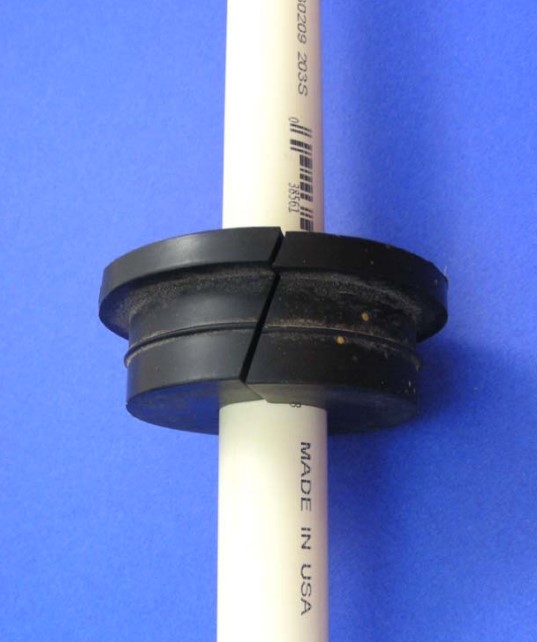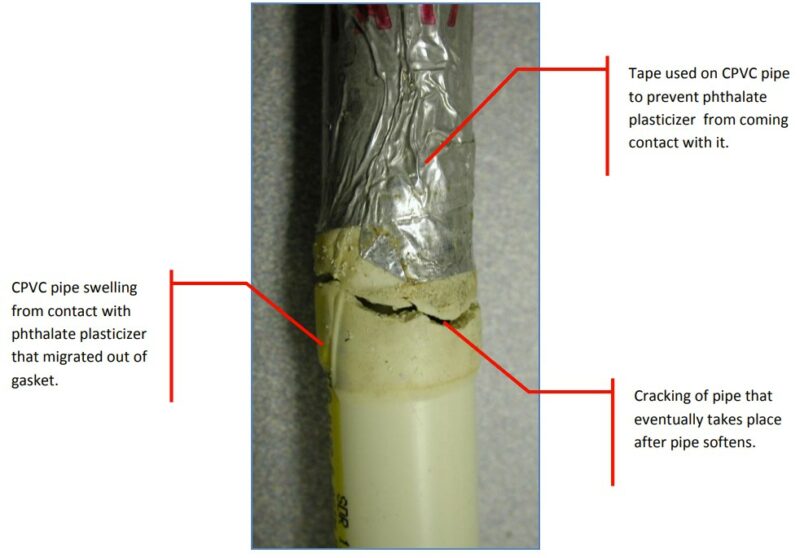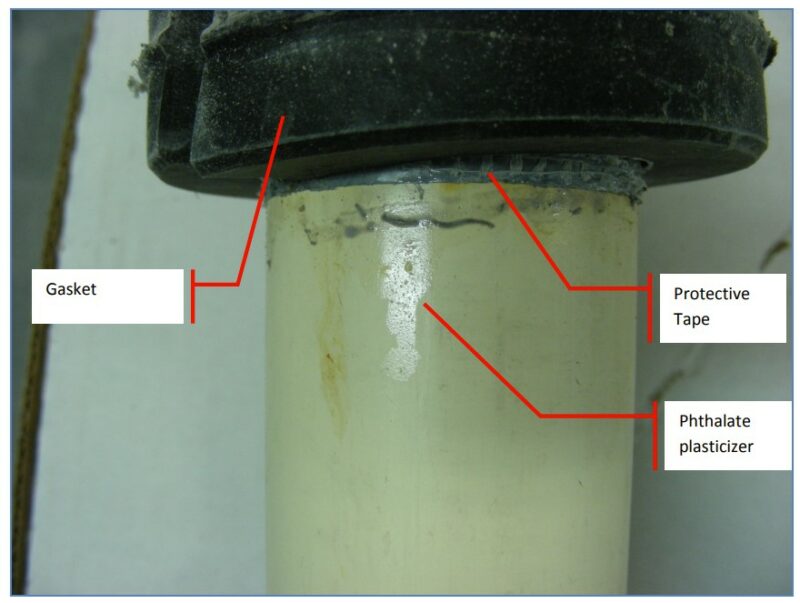There has been a rash of failures involving chlorinated poly(vinyl chlorine)(PVC) pipes that were used with black rubber gasket plugs (such as those made by ProSet Systems, Inc.), Figure 1.

Figure 1 – Rubber gasket on a CPVC pipe.
The gasket is typically used as a firestop plug and/or horizontal support as the pipe travels vertical from one floor to the next. Failures have been observed occurring anywhere from several months to years after installation. Once a failure has occurred at a location, numerous failures have followed. At the location of failure, the CPVC pipe has been observed swelling with a rubbery feel at the location of failure, Figure 2.

Figure 2 – Swelling of the CPVC pipe from absorption of phthalate that migrated out of gasket.
The rubber gasket is much like a used household sponge; it is hard and stiff without a plasticizer (water in the case of the sponge). Much like how water makes a sponge pliable, a plasticizer allows the rubber gasket to be flexible and pliable. As the name implies, the intended purpose of the plasticizer is to change the properties, specifically the stiffness, of the material it is being added to. In most cases, it is supposed to do this without separating and migrating out of the material. Unfortunately, this can be a difficult task since the plasticizer and base material are not necessarily totally compatible; similar to mixing oil and water. In fact, the plasticizer is much like oil in its consistency and how it lubricates. By “lubricating” the molecules of the rubber, it allows them to slide by one another, permitting the rubber to deform. Separation and migration of the plasticizer from the base rubber compound is a common occurrence, but can be avoided by using proper manufacturing techniques, utilizing materials that tend to be more compatible, and ensuring the environmental conditions are appropriate. People that bake are familiar with this phenomenon with the separation and migration of butter or oils from the dough if they are not mixed or baked properly. Likewise, at elevated temperatures, the plasticizer can “unlock” from the base material and flow out from the product. Also, similar to a sponge releasing water when squeezed, stress in the form of compression can help promote separation and migration by “squeezing” the plasticizer out of the product.
There are two primary issues when separation and migration of the plasticizer take place: change in properties of the rubber product the plasticizer is flowing from and changes in the product it may come in contact with. As one would expect, the product it is flowing from can be become more stiff since there will be less of the material that is making it flexible. Another less obvious problem also often occurs; it is common for the unintended product in proximity to the rubber to absorb the plasticizer and in the process swell in size. Again, this is similar to a used sponge increasing in size as it absorbs water. As the plasticizer is absorbed by the unintended material, it interferes with intermolecular forces holding the material together, leading to molecular disentanglement and eventually cracking. The phenomenon is termed environmental stress cracking (ESC)1. Some secondary issues to note when a material separates and migrates are cosmetic changes to the contacting part and flammability of the migrating material. As mentioned above, plasticizers have an oily consistency and can be flammable. Migration into an extremely hot condition, like an open flame, could result in a disastrous situation.
In this case, the phthalate‐based plasticizer separates from the rubber as described above. If allowed to come in contact with the chlorinated‐poly(vinyl chloride) (CPVC) pipe, it will be absorbed by the CPVC and in the process cause environmental stress cracking to take place. Phthalate‐based plasticizers are known to be detrimental to CPVC pipe materials. The temperature the product is exposed to can accelerate the separation and migration of the phthalate plasticizer from the gasket. For this reason, one should expect migration of the plasticizer to occur faster with the hot water supply. Once in contact with the CPVC pipe the plasticizer will migrate into the pipe causing it to swell. The pipe will soften, becoming leathery at this location. In the softened state, a crack can form. Cracking in a pressurized pipe (e.g. water supply) is more likely because of the extra stress (recall, ESC requires stress and will take place faster at higher stress levels). However, one should expect cracking to take place in an unpressurized pipe as well, since these pipes will have stress from other sources.
A fix recommended and issued by one manufacturer had the plumber apply tape to the CPVC pipe underneath the rubber gasket with the goal of preventing the plasticizer from coming in contact with the pipe. However, the tape has proven to only prolong failure from taking place in some cases. The plasticizer has been observed running down the tape and eventually coming in contact with the pipe, Figure 3. The plasticizer can also migrate through seams or tears in the tape.

Figure 3 ‐ Phthalate running down side of tape and pipe after migrating out of gasket.
This application is an example of a product that was not fully tested prior to being released into the market. Unfortunately, if the plasticizer in the gasket comes in contact with the CPVC pipe, failure will more than likely take place. This will require massive repairs since the pipes and gasket are located behind the wall. The fix that was proposed to the plumbers, prior to installation, appears to have only prolonged the inevitable – complete replacement of the piping system.
1 Jansen, J. “Environmental Stress Cracking: The Plastic Killer,” Advanced Materials & Processes, (2004)
